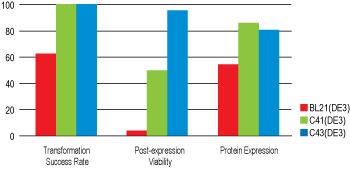OverExpress Genotypes
OverExpress C41(DE3): F – ompT hsdSB (rB- mB-) gal dcm (DE3)
OverExpress C41(DE3)pLysS: F – ompT hsdSB (rB- mB-) gal dcm (DE3) pLysS (CmR)
OverExpress C43(DE3): F – ompT hsdSB (rB- mB-) gal dcm (DE3)
OverExpress C43(DE3)pLysS: F – ompT hsdSB (rB- mB-) gal dcm (DE3) pLysS (CmR)
Table 1. OverExpress Transformation Efficiencies
| Electrocompetent Cells |
cfu/Ѕьg DNA |
| C41(DE3) |
> 1 ЁП 1010 |
| C41(DE3)pLysS |
> 1 ЁП 109 |
| C43(DE3) |
> 1 ЁП 1010 |
| C43(DE3)pLysS |
> 1 ЁП 109 |
| Chemically Competent Cells |
| C41(DE3) |
> 1 ЁП 106 |
| C41(DE3)pLysS |
> 1 ЁП 106 |
| C43(DE3) |
> 1 ЁП 106 |
| C43(DE3)pLysS |
> 1 ЁП 106 |
 IDT
IDT

